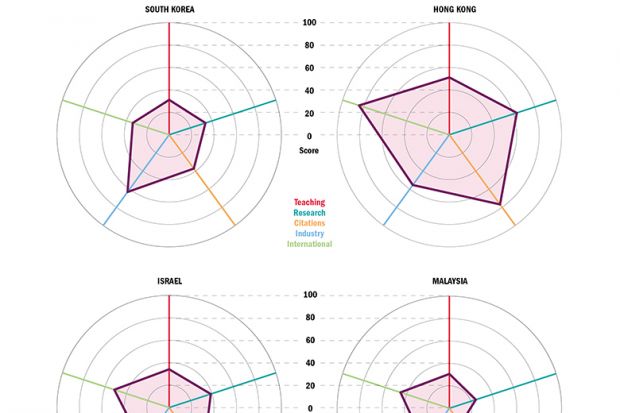Please click to see hi-res version of graphic
The universities of Asia are often lumped together in wider discussions about the direction of global higher education.
However, as these “spider” charts of different countries’ median scores on the separate pillars of the Times Higher Education Asia University Rankings 2018 show, this is a very broad and simplistic approach because each nation often has very different strengths and weaknesses.
To begin with, there is a clear split among those Asian nations that perform very strongly for the resources that are going into higher education and those others that excel in areas such as internationalisation and research quality.
Take South Korea, for example. Its median industry income score is among the highest of any nation in the region, but its score on every other pillar of the rankings is much lower (China, although not displayed, also has a similar profile).
Browse the full Asia University Rankings 2018 results
Then there is Hong Kong, which achieves a very high score on the international outlook pillar – and is also very solid on research – but seems to be held back from an across-the-board good performance by its marks on the teaching and industry income pillars.
There are some nations, meanwhile, that appear to be achieving “all-round” quality. The obvious example is Singapore, although as it has only two universities, both of which are very strong, in the ranking it is not the best comparator. Another example could be Israel, which registers much lower scores than Singapore but achieves relatively solid medians in every pillar.
Meanwhile, an interesting up-and-coming country is Malaysia, which appears to have found a way for its universities to engage internationally and with industry. If it could improve its performance on research, it might be a major higher education force to be reckoned with in the future.
Search our database for the latest university jobs in Asia
Watch our video of the 2018 results
Download a copy of the Asia University Rankings 2018 digital supplement
POSTSCRIPT:
Print headline: Rhythms shift across the region
Register to continue
Why register?
- Registration is free and only takes a moment
- Once registered, you can read 3 articles a month
- Sign up for our newsletter
Subscribe
Or subscribe for unlimited access to:
- Unlimited access to news, views, insights & reviews
- Digital editions
- Digital access to THE’s university and college rankings analysis
Already registered or a current subscriber?








